3.4.3: Color
- Page ID
- 19165
\( \newcommand{\vecs}[1]{\overset { \scriptstyle \rightharpoonup} {\mathbf{#1}} } \)
\( \newcommand{\vecd}[1]{\overset{-\!-\!\rightharpoonup}{\vphantom{a}\smash {#1}}} \)
\( \newcommand{\id}{\mathrm{id}}\) \( \newcommand{\Span}{\mathrm{span}}\)
( \newcommand{\kernel}{\mathrm{null}\,}\) \( \newcommand{\range}{\mathrm{range}\,}\)
\( \newcommand{\RealPart}{\mathrm{Re}}\) \( \newcommand{\ImaginaryPart}{\mathrm{Im}}\)
\( \newcommand{\Argument}{\mathrm{Arg}}\) \( \newcommand{\norm}[1]{\| #1 \|}\)
\( \newcommand{\inner}[2]{\langle #1, #2 \rangle}\)
\( \newcommand{\Span}{\mathrm{span}}\)
\( \newcommand{\id}{\mathrm{id}}\)
\( \newcommand{\Span}{\mathrm{span}}\)
\( \newcommand{\kernel}{\mathrm{null}\,}\)
\( \newcommand{\range}{\mathrm{range}\,}\)
\( \newcommand{\RealPart}{\mathrm{Re}}\)
\( \newcommand{\ImaginaryPart}{\mathrm{Im}}\)
\( \newcommand{\Argument}{\mathrm{Arg}}\)
\( \newcommand{\norm}[1]{\| #1 \|}\)
\( \newcommand{\inner}[2]{\langle #1, #2 \rangle}\)
\( \newcommand{\Span}{\mathrm{span}}\) \( \newcommand{\AA}{\unicode[.8,0]{x212B}}\)
\( \newcommand{\vectorA}[1]{\vec{#1}} % arrow\)
\( \newcommand{\vectorAt}[1]{\vec{\text{#1}}} % arrow\)
\( \newcommand{\vectorB}[1]{\overset { \scriptstyle \rightharpoonup} {\mathbf{#1}} } \)
\( \newcommand{\vectorC}[1]{\textbf{#1}} \)
\( \newcommand{\vectorD}[1]{\overrightarrow{#1}} \)
\( \newcommand{\vectorDt}[1]{\overrightarrow{\text{#1}}} \)
\( \newcommand{\vectE}[1]{\overset{-\!-\!\rightharpoonup}{\vphantom{a}\smash{\mathbf {#1}}}} \)
\( \newcommand{\vecs}[1]{\overset { \scriptstyle \rightharpoonup} {\mathbf{#1}} } \)
\( \newcommand{\vecd}[1]{\overset{-\!-\!\rightharpoonup}{\vphantom{a}\smash {#1}}} \)
\(\newcommand{\avec}{\mathbf a}\) \(\newcommand{\bvec}{\mathbf b}\) \(\newcommand{\cvec}{\mathbf c}\) \(\newcommand{\dvec}{\mathbf d}\) \(\newcommand{\dtil}{\widetilde{\mathbf d}}\) \(\newcommand{\evec}{\mathbf e}\) \(\newcommand{\fvec}{\mathbf f}\) \(\newcommand{\nvec}{\mathbf n}\) \(\newcommand{\pvec}{\mathbf p}\) \(\newcommand{\qvec}{\mathbf q}\) \(\newcommand{\svec}{\mathbf s}\) \(\newcommand{\tvec}{\mathbf t}\) \(\newcommand{\uvec}{\mathbf u}\) \(\newcommand{\vvec}{\mathbf v}\) \(\newcommand{\wvec}{\mathbf w}\) \(\newcommand{\xvec}{\mathbf x}\) \(\newcommand{\yvec}{\mathbf y}\) \(\newcommand{\zvec}{\mathbf z}\) \(\newcommand{\rvec}{\mathbf r}\) \(\newcommand{\mvec}{\mathbf m}\) \(\newcommand{\zerovec}{\mathbf 0}\) \(\newcommand{\onevec}{\mathbf 1}\) \(\newcommand{\real}{\mathbb R}\) \(\newcommand{\twovec}[2]{\left[\begin{array}{r}#1 \\ #2 \end{array}\right]}\) \(\newcommand{\ctwovec}[2]{\left[\begin{array}{c}#1 \\ #2 \end{array}\right]}\) \(\newcommand{\threevec}[3]{\left[\begin{array}{r}#1 \\ #2 \\ #3 \end{array}\right]}\) \(\newcommand{\cthreevec}[3]{\left[\begin{array}{c}#1 \\ #2 \\ #3 \end{array}\right]}\) \(\newcommand{\fourvec}[4]{\left[\begin{array}{r}#1 \\ #2 \\ #3 \\ #4 \end{array}\right]}\) \(\newcommand{\cfourvec}[4]{\left[\begin{array}{c}#1 \\ #2 \\ #3 \\ #4 \end{array}\right]}\) \(\newcommand{\fivevec}[5]{\left[\begin{array}{r}#1 \\ #2 \\ #3 \\ #4 \\ #5 \\ \end{array}\right]}\) \(\newcommand{\cfivevec}[5]{\left[\begin{array}{c}#1 \\ #2 \\ #3 \\ #4 \\ #5 \\ \end{array}\right]}\) \(\newcommand{\mattwo}[4]{\left[\begin{array}{rr}#1 \amp #2 \\ #3 \amp #4 \\ \end{array}\right]}\) \(\newcommand{\laspan}[1]{\text{Span}\{#1\}}\) \(\newcommand{\bcal}{\cal B}\) \(\newcommand{\ccal}{\cal C}\) \(\newcommand{\scal}{\cal S}\) \(\newcommand{\wcal}{\cal W}\) \(\newcommand{\ecal}{\cal E}\) \(\newcommand{\coords}[2]{\left\{#1\right\}_{#2}}\) \(\newcommand{\gray}[1]{\color{gray}{#1}}\) \(\newcommand{\lgray}[1]{\color{lightgray}{#1}}\) \(\newcommand{\rank}{\operatorname{rank}}\) \(\newcommand{\row}{\text{Row}}\) \(\newcommand{\col}{\text{Col}}\) \(\renewcommand{\row}{\text{Row}}\) \(\newcommand{\nul}{\text{Nul}}\) \(\newcommand{\var}{\text{Var}}\) \(\newcommand{\corr}{\text{corr}}\) \(\newcommand{\len}[1]{\left|#1\right|}\) \(\newcommand{\bbar}{\overline{\bvec}}\) \(\newcommand{\bhat}{\widehat{\bvec}}\) \(\newcommand{\bperp}{\bvec^\perp}\) \(\newcommand{\xhat}{\widehat{\xvec}}\) \(\newcommand{\vhat}{\widehat{\vvec}}\) \(\newcommand{\uhat}{\widehat{\uvec}}\) \(\newcommand{\what}{\widehat{\wvec}}\) \(\newcommand{\Sighat}{\widehat{\Sigma}}\) \(\newcommand{\lt}{<}\) \(\newcommand{\gt}{>}\) \(\newcommand{\amp}{&}\) \(\definecolor{fillinmathshade}{gray}{0.9}\)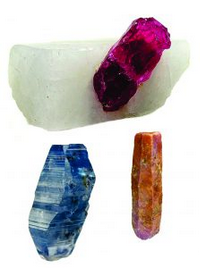
Color is often used for quick identification of minerals. Sometimes, it can be diagnostic, but for many minerals it is ambiguous or even misleading. The deep red color of rubies may seem distinctive. Ruby is, however, just one variety of the mineral corundum. Sapphires are different colored varieties of the same mineral. The photos in Figure 3.41 show just a few of the many colors that corundum may have. To add to the confusion, other minerals, such as spinel or garnet, may have the same deep red color as ruby. Color is ambiguous because many things can give a mineral its color.
Color is one of the most misunderstood mineral properties. It is easy to look at a ruby illuminated by white light and say it has a red color. If the ruby is illuminated by light of a different color, it may not appear red. Color, then, is not just a property of a mineral. It is instead the result we observe when light and a mineral interact. When we see that a mineral has color, what we are really observing is the color of the light that is being reflected or transmitted to our eye. Normal light, called white light, includes many different colors (wavelengths). When white light strikes a mineral surface, if all of the colors are reflected back to our eyes, the mineral will appear white. If none of the colors are reflected back to our eye, the mineral will appear black. Most minerals, like ruby, appear to have color because only one or a few wavelengths of light reflect and make it back to our eye. The other wavelengths are absorbed or transmitted by the mineral in some way.
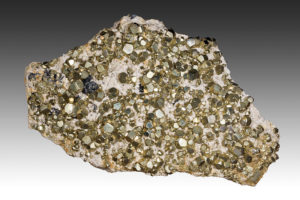
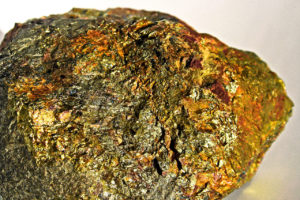
Metallic minerals, especially sulfides, tend to be constant in their coloration. So mineralogists commonly use color as a key tool for sulfide identification. However, metallic minerals easily tarnish, so we need a fresh surface to see the true color. The photos above show pyrite on top of dolomite (left photo) and chalcopyrite (right photo). The pyrite specimen also contains a few crystals of dark colored hematite.
Pyrite and chalcopyrite are both sulfides, but pyrite is FeS2 and chalcopyrite has formula CuFeS2. Both sulfides are quite common and color usually distinguishes one from the other – pyrite is more golden or brass colored, and chalcopyrite generally has a yellowish tint and sometimes appears a bit greenish. Notice that the chalcopyrite is tarnishing to an orangish color.
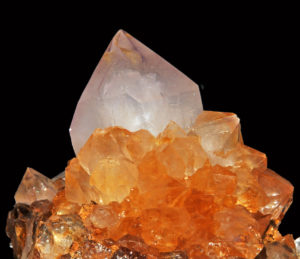
Color is often a poor property to use for identifying nonmetallic minerals because many things can cause minerals to have different colors. For example, quartz may be colorless, rosy (rose quartz), yellow (citrine), purple (amethyst), milky, smoky, or black. The photo seen here in Figure 3.44 contains both light purplish amethyst and orangish citrine.
The most significant control on color is a mineral’s chemical composition. Elements that give a mineral its color are called chromophores. It does not take large amounts of chromophores to color a mineral. Minor amounts, less than 0.1 wt% of transition metals such as iron and copper, may control a mineral’s color because electrons in the d-orbitals of transition metals are extremely efficient at absorbing certain visible wavelengths of light. The remaining wavelengths are reflected and give minerals their color.
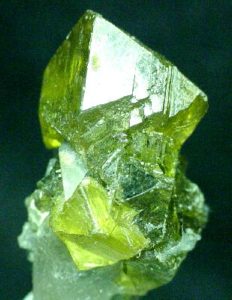
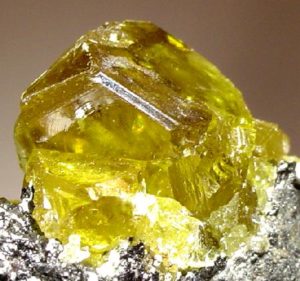
If the elements controlling the selective reflection of certain wavelengths are major components in a mineral, the mineral is idiochromatic, or “self-coloring.” Sphalerite (ZnS), for example, is an idiochromatic mineral. It changes from white to yellow to green to brown to black as its composition changes from pure ZnS to a mixture of ZnS and FeS. The two photos seen here are from the same mining district in New York but are different colors. Compare these with other photos of sphalerite earlier in this chapter (Figures 3.23 and 3.26). Sphalerite has a lot of different looks and colors!

Many copper minerals are idiochromatic and have green or blue coloration, while many manganese minerals are pinkish. These colors derive from selective absorption of certain colors by copper and manganese. Idiochromatic elements may have different effects in different minerals. Malachite and azurite, seen in the photo here (Figure 3.47), are both hydrated copper carbonates, but malachite is green and azurite is blue. In both minerals the color is due to copper.
Ruby and sapphire are examples of allochromatic varieties of corundum. In allochromatic minerals, minor or trace elements determine the color. Very small amounts of iron and titanium give sapphire a deep blue color. Small amounts of chromium give ruby and other gemstones deep red colors. Like the effects of idiochromatic elements, the effects of allochromatic elements may be different in different minerals. Allochromatic chromium is also responsible for the striking green color of emerald (a variety of the mineral beryl), chrome diopside, and some tourmalines.
Structural defects in minerals may also influence their color. Radiation damage gives quartz, for example, a purple, smoky, or black color. The purple color of many fluorites is caused by Frenkel defects (out of place ions in the atomic structure). Other causes of coloration include the oxidation or reduction of certain elements (especially iron), and the presence of minute inclusions of other minerals.


